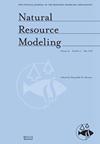Assessing the potential economic effects of mesopelagic fisheries as a novel source of fishmeal
IF 2.1
4区 环境科学与生态学
Q3 ENVIRONMENTAL SCIENCES
引用次数: 0
Abstract
The continuous growth of the aquaculture industry implies increased demand for efficient sources of aquafeed, such as fishmeal. Pelagic fish are a desirable source of fishmeal due to their high nutritional content. Nevertheless, several pelagic stocks that have been exploited extensively for fishmeal production face ecological limits due to commercial exploitation, and the aquaculture industry is now seeking novel, efficient, and sustainable sources of aquafeed. The mesopelagic zone, an ecosystem with many scientific uncertainties, is being considered as a potential source for fishmeal, largely owing to the abundance of mesopelagic fish and their robust nutritional profile. However, both the ecological and economic viability of commercial exploitation of mesopelagic fish are not yet well understood. To understand the conditions that would make such an endeavor economically viable in the context of global fishmeal production systems, we use a bioeconomic model that assesses the economic consequences of including mesopelagic fish as a fishmeal source. Through simulations, we assess the economic implications of this hypothetical mesopelagic fishery on major pelagic fishmeal production systems. The mesopelagic fishery can be economically profitable for harvesters, and its addition to global fishmeal production reduces fishmeal market price, thus making it more accessible to aquaculture farmers and less profitable for pelagic fishers. While this may reduce fishing pressure on pelagic forage‐fish stocks, the implications of commercial exploitation of mesopelagic on key ecosystem services remain a concern.评估中上层渔业作为鱼粉新来源的潜在经济影响
水产养殖业的持续增长意味着对鱼粉等高效水产饲料来源的需求增加。中上层鱼类营养丰富,是理想的鱼粉来源。然而,由于商业开发,一些被广泛用于生产鱼粉的中上层鱼类种群面临生态限制,水产养殖业目前正在寻求新型、高效和可持续的水产饲料来源。中上层鱼类资源丰富,营养价值高,因此,中上层鱼类区这一具有许多科学不确定性的生态系统正被视为鱼粉的潜在来源。然而,中上层鱼类商业开发的生态和经济可行性尚未得到充分了解。为了了解在全球鱼粉生产系统的背景下,这种努力在经济上可行的条件,我们使用了一个生物经济模型,评估将中上层鱼类作为鱼粉来源的经济后果。通过模拟,我们评估了这种假定的中深海渔业对主要中上层鱼粉生产系统的经济影响。中上层鱼类渔业可为捕捞者带来经济利润,将其纳入全球鱼粉生产可降低鱼粉市场价格,从而使水产养殖者更容易获得鱼粉,而中上层鱼类捕捞者的利润则会降低。虽然这可能会减少对中上层觅食鱼类种群的捕捞压力,但商业开发中上层鱼类对关键生态系统服务的影响仍然令人担忧。
本文章由计算机程序翻译,如有差异,请以英文原文为准。
求助全文
约1分钟内获得全文
求助全文
来源期刊

Natural Resource Modeling
环境科学-环境科学
CiteScore
3.50
自引率
6.20%
发文量
28
审稿时长
>36 weeks
期刊介绍:
Natural Resource Modeling is an international journal devoted to mathematical modeling of natural resource systems. It reflects the conceptual and methodological core that is common to model building throughout disciplines including such fields as forestry, fisheries, economics and ecology. This core draws upon the analytical and methodological apparatus of mathematics, statistics, and scientific computing.
 求助内容:
求助内容: 应助结果提醒方式:
应助结果提醒方式:


